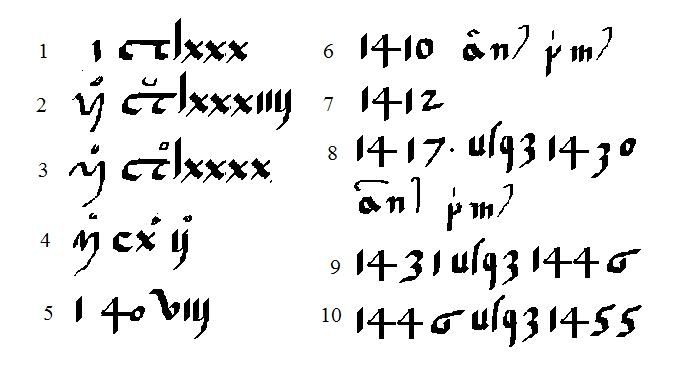A fascinating email just arrived at Cipher Mansions from Tony Gaffney, our virtual cryptologer-in-residence at the British Library. While looking at BL Add. MS 39660 recently, he noticed a set of dates for ten popes written in an unusual mixture of Roman numbers and Arabic numerals (“an9 pm9” = “annus primus“, and “ufq3” = “usque“):-
That is:-
- cclxxxij
- m cclxxxiiij
- m cc lxxxx
- m cx ij
- 1 40 viij
- 1 4 10 an9 pm9
- 14 12
- 14 17 ufq3 1430 an9 pm9
- 1 431 ufq3 1446
- 14 46 ufq3 1455
According to the BL’s bibliographic description, this was written on paper in Italy, with the later popes added not before 1455: while Tony adds that the “v” in the fifth date “is written in the old style of a backward sloping b“, hence a 15th century hand. All of which gives us a basic prediction for where and when we might expect to find this unusual kind of mixed Roman / Arabic numbers: Italy in the second half of the 15th century. Examining BL Add. MS 39660 even more closely may to help us be more specific: but that’s a job for another day.
The presence of “pm9” here is particularly heartening, as this is precisely what is used for the quire number in Q1 of the Voynich Manuscript. Intriguingly, Tony notes that the “cc” pairs in the first three dates are ligatured at the top, just like the EVA “ch” glyph, though he has previously seen this in the 14th century Royal MS 12BXXV f.283 (which is a “table converting Arabic & Latin numbers“). And furthermore, he adds that “in the fifth [date], we have not only a combination of Arabic and Latin numbers but the 4o is the Voynich EVA qo linked!!“. Of course, that might just be a coincidence, but even so…

Hi Nick – very interesting… any chance of some scans ?
The British Library charges fairly highly for scans of each page, and these dates are scattered across a number of pages… so, in the absence of any bankrolling billionnaires, we may have to live without them for a while. 🙁
hand copy
[IMG]http://i262.photobucket.com/albums/ii112/tony59b/popesnumerals.jpg[/IMG]
Thanks – the ‘qo’ and the ligatured ‘chs’ with diacritics are especially striking.
Robin
The habit entered classical Arabic from some of the older Aramaic-related scripts, in use in the eastern Roman empire, of course, and well before the advent of Islam. This habit is one of the factors which leads me to posit a dating for the content (not the Voynich ms per se) in the late-classical/early Christian era, and to attribute the content’s to the eastern networks of the spice trade.
*content’s range of matter…